Exploring Post Recaps 2013–2014
April 21, 2014
Jonathan Weissler, M.D., Chief of Medicine, Professor, and Vice Chairman, Internal Medicine
For our April Exploring Post meeting, we had a presentation by Jonathan Weissler, M.D., Chief of Medicine, Professor, and Vice Chair of Internal Medicine. Dr. Weissler gave a presentation on his career as a pulmonologist and the different pathways that an academic physician can take, including his current administrative role as Chief of Medicine for UT Southwestern University Hospitals. He encouraged students to develop many skills other than science, such as business or public health.
March 24, 2014
Gary Reed, M.D., Chief Quality Officer, Professor of Internal Medicine
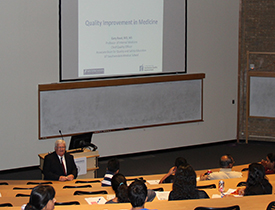
During our March Exploring Post meeting, we had a presentation by Gary Reed, M.D., Chief Quality Officer and Professor of Internal Medicine. Dr. Reed discussed his professional pathway to becoming an internal medicine doctor and his current administrative role as the Chief Quality Officer. After the presentation, we had officer elections. Current officers gave presentations on their duties for this past year, their experiences, and why students should nominate themselves or others for a leadership role. The following students will fulfill officer roles for the 2014–2015 year: Imari Parham (President), Christine Ramjee (Administrative VP), Anika Reddy (Program VP), and Kelsey Shipman (Secretary).
February 24, 2014
Jeremy Reimers, Ph.D., Postdoctoral Researcher II, Neurology and Neurotherapeutics
The Explorers learned about Neurology and Neurotherapeutics from Jeremy Reimers, Ph.D. Dr. Reimers started with an activity to familiarize everyone with the brain and neurons. Then he talked about his path to a biomedical research career, his current teaching position, and his own experiences in the field working with animal models to study addiction as well as autism.
January 27, 2014
Ryan Golden, MSTP Student, Molecular Biology
We had the biggest group to date of 89 students for the first meeting of 2014. There was a presentation by Ryan Golden, MSTP Student. He gave a presentation on his pathway to choosing an MSTP program, the requirements and components of the program, and his current graduate research in the Mendell Lab studying microRNAs and other noncoding RNAs in normal physiology and disease. After the presentation, the students went to the Willed Body Program at UT Southwestern Medical Center for an anatomy presentation.
December 16, 2013
Lauren Tyra, Student Research Assistant, Neuroscience
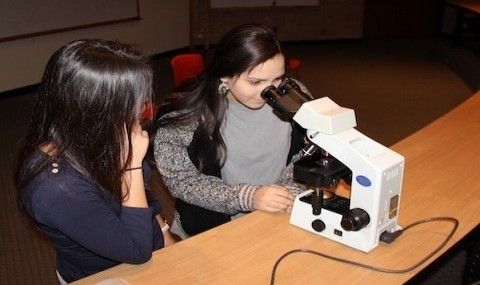
November 18, 2013
Isabel Teo, Clinical Nutrition Student; and Peter Harris, Safety Specialist III.
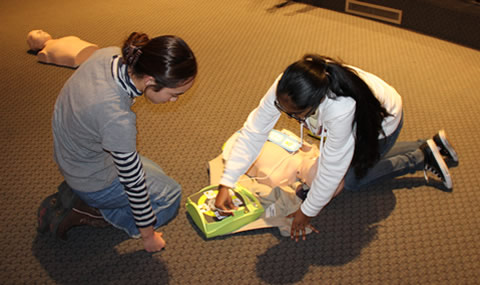
There were two presentations during our November 18 meeting. During the first half, the Explorers had the privilege of listening to Isabel Teo, Clinical Nutrition Student.
They learned about sports/fitness nutrition and different labels that one might find on food packaging. Some of the labels are misleading, such as foods labeled fat-free. Fat free does not necessarily equal calorie-free, and as a result, many fat-free foods contain almost he same amount of calories. The members then received a specific food labels to inspect with one another and present to the group.
As a final activity, everyone was presented with a recipe to make a healthy sports drink at home. The second half of the meeting was led by Peter Harris, Safety Specialist III., on CPR and AED use. After a short presentation on the procedures, students were allowed to test out the newly learned skills on CPR mannequins. It was another successful meeting learning more about different health and science careers.
October 21, 2013
Megan Farley, M.S., C.G.C., Genetic Counselor
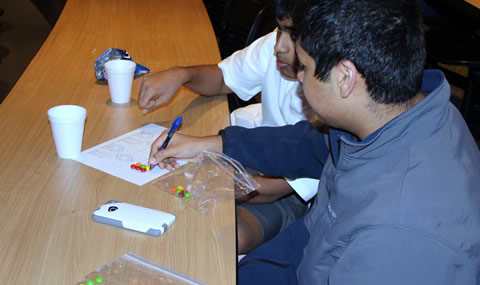
Our October 21 meeting was led by genetic counselor Megan Farley. She focused on:
- How genetic counselors help patients identify risks of developing certain genetic disorders
- Give advice on treatment options
- The risks to future offspring
Ms. Farley also covered different genetic disorder markers and how her job is two-fold. The first was to tell the patients how to cope – this can include giving them information about treatments. The other part is telling them about other miscues or things that looked to be of future concern in both theirs and their child's DNA.
After her enlightening presentation, she led the Explorers on a hands-on genetic mutations activity with Pedigree Charts and Skittles.™
September 23, 2013
Virginia Rady, R.N., M.S.N., ANP-C, Nurse Practitioner
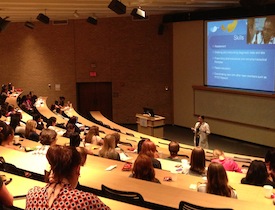
During our Open House on September 23, we had our biggest group: 80 students. The presentation was by Virginia Ann Rady, a nurse practitioner. She provided us with some history of nurse practitioners, which came about in the 1960s as a result of the shortage of doctors in primary care. Nurse practitioners can make diagnoses and treatment plans, prescribe medications, and order referrals. Their main job is to educate the patient on what exactly is happening to them and why. Currently to become a nurse practitioner, one must get a bachelor’s degree, become a registered nurse, receive a master’s, and gain a state nurse practitioner’s license. In the future, more schooling will be required. Nurse practitioners are steadily becoming a more recognized and sought-after resource in a world with too few doctors.
